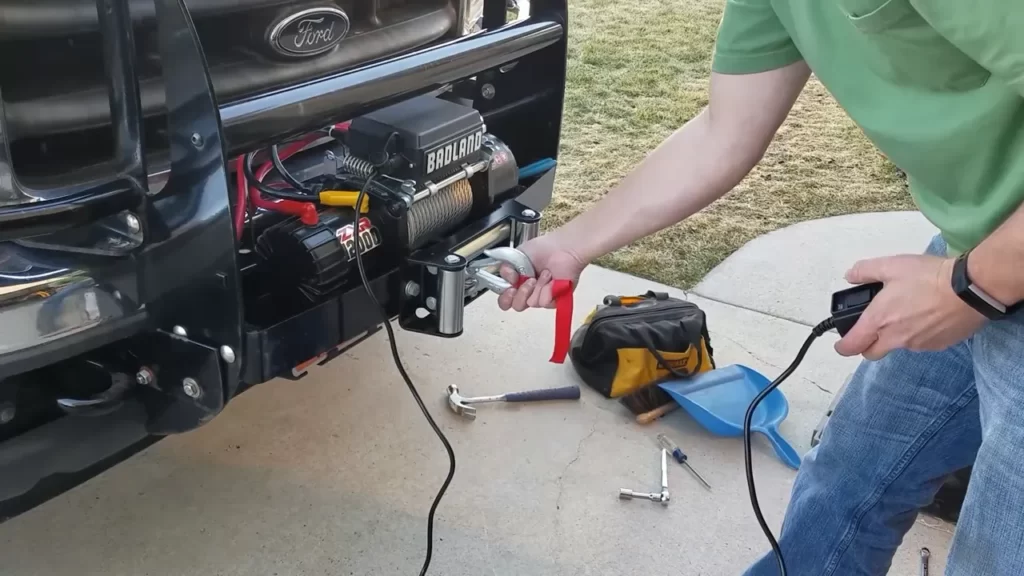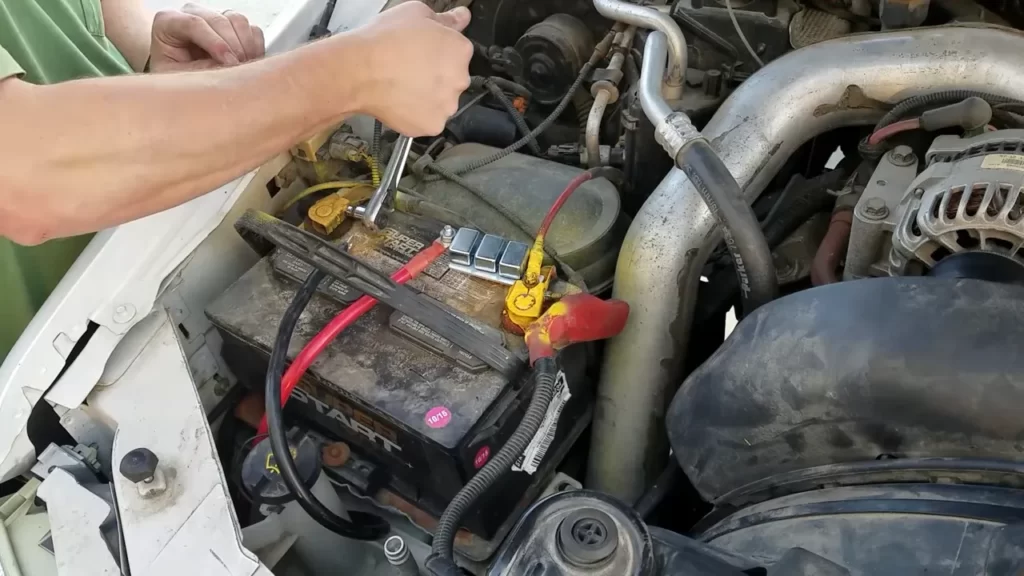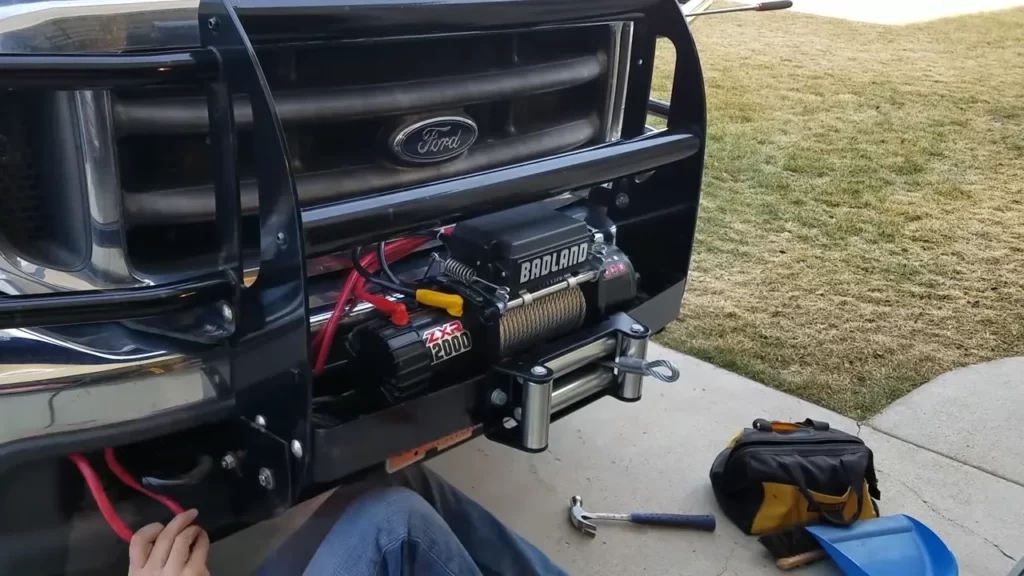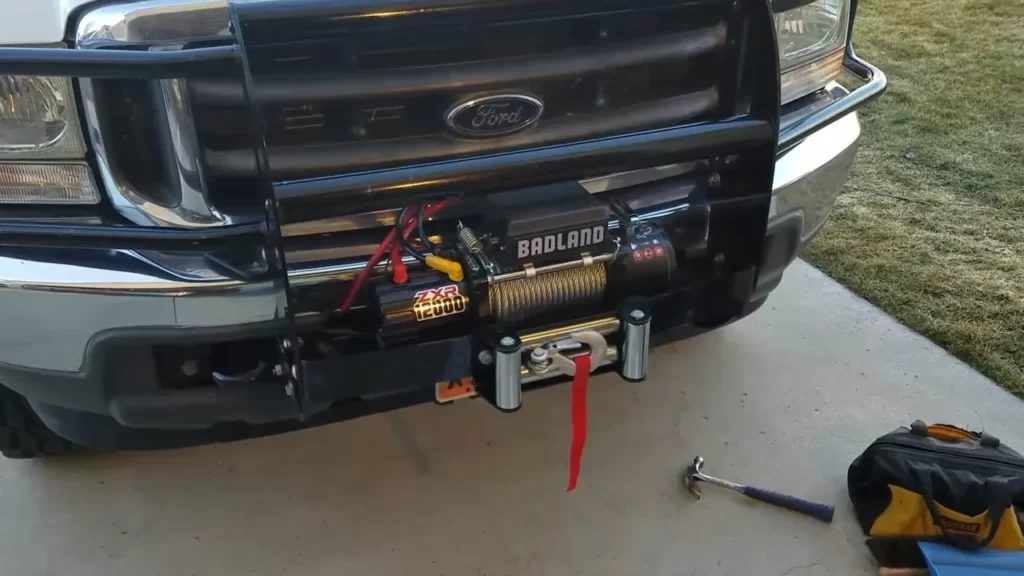To install a winch on a truck, position and secure the winch mount on the truck’s front bumper using the included hardware. If you’re an avid off-roader or frequently find yourself in situations where you need to tow or recover vehicles, a winch can be an essential addition to your truck.
A winch is a powerful tool that can help you pull your truck or others out of sticky situations. It’s important to have the right equipment and know-how to install the winch properly. We will guide you through the step-by-step process of installing a winch on your truck.
By following these instructions, you can have a winch installed and ready for action in no time. So, let’s dive in and get started on mounting that winch!
Choosing The Right Winch For Your Truck
When it comes to off-roading adventures or heavy-duty work, having a winch installed on your truck can be a game-changer. A winch is a powerful tool that can assist you in recovering a stuck vehicle or pulling heavy loads. However, with so many options available on the market, it’s important to choose the right winch for your truck to ensure optimum performance and safety.
Factors to Consider When Selecting a Winch
Before diving into the installation process, let’s take a look at some important factors to consider when selecting the perfect winch for your truck.
Vehicle Specifications
First and foremost, it’s crucial to take your truck’s specifications into account. Each vehicle has its own weight, size, and towing capabilities, which will determine the type of winch you need. Pay attention to your truck’s manufacturer guidelines and make sure to choose a winch that is compatible with your specific truck model.
Weight Capacity
The weight capacity of a winch is another vital aspect to consider. You need to ensure that the winch you select can handle the maximum weight that you anticipate pulling. To determine the appropriate weight capacity, consider both the weight of your truck as well as the weight of any potential loads you may need to tow. It’s always better to go for a winch with a slightly higher weight capacity to have a margin of safety.
Cable Length
Another crucial factor to think about is the cable length of the winch. The cable length should be long enough to reach an anchor point, which could be a tree, another vehicle, or a recovery point. Measure the distance between common anchor points and choose a winch with a cable length that exceeds this distance.
Keep in mind that you can always use extension cables or add-on accessories to extend the effective length of the cable, but it’s essential to have a winch with a cable that’s long enough for your regular needs.
By considering these important factors, you can ensure that you choose the right winch for your truck. Now that you have a clear understanding of what to look for, let’s move on to the installation process and get your winch up and running.
Preparing Your Truck For Winch Installation
Before you can start enjoying the benefits of a winch on your truck, it’s essential to prepare your vehicle for the installation process. By taking the time to assess your truck’s front end and ensure proper clearance, you can ensure a smooth and successful winch installation. In this article, we’ll cover the different steps you need to take in order to get your truck ready for a winch installation.
Assessing Your Truck’s Front End
The first step in preparing your truck for winch installation is to assess the front end. This involves examining your vehicle to determine its suitability for mounting a winch. Below are some key factors to consider:
- Front grille design: Some truck models might require modifications to accommodate a winch. Check your truck’s front grille design to ensure it can properly house the winch.
- Structural integrity: Assess the front end of your truck to ensure it is sturdy and can support the weight and force exerted by the winch.
- Compatibility with winch mounting options: Different winch models come with various mounting options. Verify that your truck is compatible with the mounting style you intend to use.
Checking for Adequate Mounting Points
Once you have determined that your truck is suitable for winch installation, the next step is to check for adequate mounting points. These mounting points are the attachment locations on your truck’s front end where the winch will be secured. Here’s what to look for:
- Existing mounting points: Check if your truck already has factory-installed mounting points intended for winch installation. These are typically indicated by reinforced metal plates or brackets.
- Structural integrity of mounting points: Ensure that the existing mounting points are in good condition and able to withstand the added stress from the winch. Repair or reinforce weak or damaged mounting points as needed.
- Compatibility with winch mount: Compare the existing mounting points with the winch mount to ensure they align. If they do not match, additional modifications may be necessary.
Ensuring Proper Clearance
Proper clearance is crucial to prevent any obstructions that could interfere with the functioning of your winch. The following steps will help ensure you have sufficient clearance:
- Measure space requirements: Determine the required space for the winch and associated components. Consider factors such as the winch drum size, fairlead, and control box to account for proper clearance.
- Verify clearances with manufacturer guidelines: Consult the winch manufacturer’s guidelines to confirm the required clearances for their specific winch model.
- Check for potential obstructions: Inspect the front end of your truck for any potential obstructions, such as radiator hoses, electrical wiring, or air conditioning components. Make necessary adjustments or modifications to ensure there is ample space for the winch installation.
Strengthening the Front End

Before mounting the winch, it’s essential to ensure that your truck’s front end is adequately strengthened to withstand the forces generated during winching operations. Here are some steps you can take:
- Inspect the front frame: Examine the front frame of your truck for any signs of wear, damage, or corrosion. Reinforce or repair any weak areas before proceeding with the winch installation.
- Add cross braces: Install cross braces or reinforcing plates to enhance the structural integrity of the front end. These additional supports can help distribute the load from the winch and minimize stress on the frame.
- Consider frame-mounted winch bumpers: Upgrading to a frame-mounted winch bumper can provide extra strength and stability to the front end, particularly if your truck’s stock bumper is not designed for winch installation.
Reinforcing the Bumper
If you plan to mount the winch on your truck’s stock bumper, it’s crucial to reinforce it to ensure proper weight distribution and prevent damage. Follow these steps to reinforce your bumper:
- Inspect the bumper: Check for any signs of weakness or damage on your truck’s stock bumper. Reinforce or repair weak areas to ensure it can handle the weight of the winch.
- Add support brackets: Install support brackets to reinforce the bumper and distribute the load from the winch across a larger surface area. These brackets can help prevent the bumper from bending or cracking under the winching force.
Upgrading the Suspension
Winches can place additional stress on your truck’s suspension system. Upgrading the suspension can help prevent sagging or excessive strain on your vehicle. Here are some options to consider:
- Heavy-duty coil springs: Replace the stock coil springs with heavy-duty ones to provide better support and resistance to sagging.
- Leaf springs: If your truck has leaf springs, consider upgrading to higher-rated ones capable of handling the additional weight from the winch.
- Air suspension: Another option is to install an air suspension system, allowing you to adjust the suspension’s firmness based on the load and winching requirements.
By following these steps to prepare your truck for winch installation, you can ensure a safe and efficient setup. Remember to always consult your truck’s manufacturer guidelines and seek professional assistance if needed. By properly preparing your truck, you’ll be ready for the exciting possibilities that come with having a winch at your disposal.
Installing The Winch On Your Truck
When it comes to off-roading or tackling rugged terrain, having a winch on your truck can be a game-changer. It provides you with the ability to pull yourself out of sticky situations and help others in need. But before you can start using your winch, you need to know how to install it properly on your truck. In this guide, we’ll walk you through the step-by-step process of mounting, securing, and connecting a winch to your truck’s battery. Let’s get started!
Mounting the Winch on the Bumper
The first step in the installation process is to mount the winch on your truck’s bumper. This is typically done using a winch mounting plate or a winch bumper, depending on the specific make and model of your truck. To mount the winch, follow these steps:
- Remove the front bumper of your truck, if necessary, to gain access to the mounting area.
- Place the winch mounting plate or winch bumper onto the front of your truck.
- Align the mounting holes on the winch with the holes on the mounting plate or bumper.
- Secure the winch in place using the provided bolts and washers.
- Tighten the bolts to ensure the winch is securely attached to the bumper.
Choosing the Ideal Location

Choosing the ideal location for your winch is crucial to ensure it functions properly and is easily accessible when you need it. Consider the following factors when determining where to mount your winch:
- Clearance: Make sure there is enough clearance between the winch and other components of your truck, such as the grille or radiator.
- Accessibility: The winch should be easily accessible for operation and maintenance.
- Weight distribution: Mount the winch in a location that promotes proper weight distribution for optimal performance.
Securing the Winch
Once the winch is mounted in the ideal location, it’s important to secure it properly to prevent any movement during operation. Follow these steps to secure the winch:
- Double-check that all mounting bolts are tightened securely.
- Use lock washers or thread-locking adhesive to further secure the bolts.
- Inspect the winch for any signs of loose connections or components.
- Ensure that the winch is aligned properly and centered within the mounting area.
Connecting the Winch to the Battery
The next step is to connect the winch to your truck’s battery to power its operation. Here’s how to do it:
- Locate your truck’s battery and ensure it is in good condition with proper voltage.
- Disconnect the negative (-) cable from the battery to prevent any electrical accidents.
- Connect the positive (+) cable from the winch to the positive terminal of the battery.
- Connect the negative (-) cable from the winch to a solid grounding point on your truck, such as the engine block or chassis.
- Tighten the cable connections securely to ensure a reliable electrical connection.
Preparing the Electrical Connections
Before installing the wiring and controls for your winch, it’s important to prepare the electrical connections. Follow these steps:
- Inspect the winch’s control box to locate the positive (+) and negative (-) terminals.
- Prepare the power cables by stripping the insulation off the ends.
- Connect the positive (+) power cable to the positive terminal of the winch’s control box.
- Connect the negative (-) power cable to the negative terminal of the winch’s control box.
- Secure the cable connections with appropriate connectors or crimp them tightly.
Installing the Wiring and Controls
With the electrical connections prepared, it’s time to install the wiring and controls for your winch. Here’s what you need to do:
- Route the winch’s control cables towards your truck’s cab through a safe and protected path.
- Connect the control cables to the winch’s control box, ensuring proper alignment.
- Follow the manufacturer’s instructions to install the winch controls in a convenient location inside your truck.
- Secure the wiring and controls to prevent any interference or damage during operation.
- Test the winch to ensure all the wiring and controls are functioning properly.
With the winch now properly installed on your truck, you can confidently tackle challenging terrains and rely on your winch to get you out of tough spots. Remember to always follow the manufacturer’s instructions and proper safety procedures when using your winch. Stay safe and enjoy your off-roading adventures!
Testing And Maintaining Your Winch
Once you have successfully installed a winch on your truck, it’s important to regularly test and maintain its functionality. Testing the winch operation, checking the remote control, verifying the cable tension, performing winch maintenance, and troubleshooting common issues are all vital for ensuring your winch is in optimal working condition. In this section, we will delve into the specifics of how to test and maintain your winch, providing you with essential information to keep it performing reliably when you need it most.
Testing the Winch Operation

To ensure the winch is functioning as intended, it’s crucial to test its operation before relying on it in a real situation. Begin by inspecting the winch’s mounting and electrical connections for any signs of damage or loose connections. Once you’ve confirmed everything is secure, follow these steps to test the winch:
- Engage the winch’s clutch, which typically requires pulling the knob or lever towards you.
- Activate the winch using the remote control, paying close attention to its responsiveness and smooth operation.
- Observe the cable spooling out and in without any abnormal noises or hesitations.
- Ensure the winch stops automatically when fully extended or retracted.
- Test the winch under load by attaching it to a suitable anchor point and applying tension to the cable. Verify that the winch pulls smoothly and does not exhibit any signs of strain or failure.
Checking the Remote Control
The remote control is an integral part of operating your winch, so it’s essential to regularly check its condition to ensure it’s functioning correctly. Follow these steps to perform a remote control check:
- Inspect the remote control for any signs of physical damage, such as cracks or water ingress.
- Check the batteries and replace them if necessary, making sure to use the correct type specified by the winch manufacturer.
- Test the remote control’s range by standing at various distances from the winch while activating it. Pay attention to any signal interference or diminished performance.
Verifying the Cable Tension
Proper cable tension is vital for the efficient operation and longevity of your winch. Follow these steps to verify the cable tension:
- Ensure the winch drum is empty, free of any cable spooling out or in.
- Measure the tension of the cable using a tension meter or a winch tension gauge. Refer to your winch’s user manual for the recommended tension range.
- Adjust the cable tension if necessary by loosening or tightening the winch drum’s tension plate or spring mechanism.
Winch Maintenance and Troubleshooting
Maintaining your winch is key to its longevity and reliable performance. Regular maintenance tasks and troubleshooting techniques ensure any potential issues are addressed promptly. Here are some important winch maintenance and troubleshooting tips:
- Cleaning and lubricating the winch: Keep your winch clean by removing any dirt, grime, or debris using a non-corrosive cleaner. Lubricate the winch components as recommended by the manufacturer to prevent rust and ensure smooth operation.
- Addressing common issues: Some common winch issues include overheating, electrical problems, and motor malfunctions. Consult the user manual or contact the manufacturer for specific troubleshooting steps to resolve these issues.
Safety Considerations And Best Practices
Practicing Safe Winching Techniques
When it comes to installing a winch on your truck, safety should always be your top priority. By following proper winching techniques, you can ensure both your safety and the well-being of your vehicle. Whether you’re pulling a truck out of a ditch or moving heavy objects, here are a few key practices to keep in mind:
- Always assess the situation and plan your winching strategy before starting the process.
- Ensure the winch is securely mounted to a strong anchor point on your truck, such as a proper bumper or frame.
- Regularly inspect your winch and its components for any signs of wear or damage.
- Use the appropriate winch line, taking into consideration the weight and type of object you are pulling.
Wearing Protective Gear
When operating a winch, wearing the right protective gear is crucial to minimize the risks of accidents and injuries. Here are some recommended safety equipment to consider:
- Heavy-duty gloves to protect your hands from sharp objects or a heated winch line.
- Sturdy boots to provide proper foot support and protect from potential hazards.
- Safety glasses or goggles to shield your eyes from flying debris or winch line recoil.
- A hard hat to provide head protection in case of falling objects or accidents.
Avoiding Dangerous Situations
Winching can introduce potential dangers if not performed with caution. To ensure your safety, always avoid the following situations:
- Never stand in the direct line of the winch cable or strap, as it can snap under tension and cause severe injuries.
- Avoid overloading the winch or exceeding its weight capacity, as this can strain the winch and lead to equipment failure.
- Do not winch from unstable anchor points, such as trees without strong roots or unstable structures.
- Avoid winching on steep or uneven surfaces, as this may cause your truck to roll or slide.
Essential Safety Tips
In addition to the above considerations, here are some essential safety tips to ensure a safe winching operation:
- Keep bystanders and other vehicles at a safe distance from the winching area to prevent accidents.
- Engage the truck’s parking brake and place wheel chocks on the tires to prevent unintended movement.
- Always operate the winch from a safe distance using the winch remote control.
- Regularly check the winch cable for any frays, kinks, or other signs of damage.
- Inspect the winch’s control switch and wiring connections to ensure they are working properly.
Using a Snatch Block for Increased Pulling Power

If you need to increase the pulling power of your winch, using a snatch block can be a helpful technique. A snatch block is a pulley-like device that allows you to change the direction of the winch line. Here’s how to use a snatch block:
- Select a strong and secure anchor point away from the direction you want to pull.
- Attach the snatch block to the anchor point using a sturdy rope or strap.
- Thread the winch line through the snatch block pulley and back towards your vehicle.
- Attach the end of the winch line to your vehicle, ensuring a proper connection.
- Operate the winch as usual, and you’ll benefit from the increased pulling power provided by the snatch block.
Properly Spooling and Storing the Winch Cable
Once you’ve completed your winching task, it’s essential to properly spool and store the winch cable for future use. Follow these steps:
- Make sure the winch cable is evenly spooled onto the drum.
- Inspect the cable for any damages or kinks and replace if necessary.
- Secure the loose end of the cable to prevent it from unraveling.
- Store the winch cable in a clean and dry location, away from direct sunlight.
- Regularly inspect and lubricate the winch’s moving parts for optimal performance.
Frequently Asked Questions On How To Install A Winch On A Truck
Can You Install A Winch Yourself?
Yes, you can install a winch yourself. Just follow the manufacturer’s instructions carefully to ensure proper installation. It’s important to have basic mechanical knowledge and the right tools for the job. If you’re not confident, it’s recommended to seek professional assistance.
Where Is The Best Place To Mount A Winch On A Truck?
The best place to mount a winch on a truck is on the front bumper or on a winch mount designed specifically for your truck model. Mounting the winch on the front allows for easy access and better weight distribution for pulling.
How Do You Wire A Winch To A Truck?
To wire a winch to a truck, first connect the positive cable to the positive post on the winch and the negative cable to the negative post. Then, connect the positive cable from the truck’s battery to the positive post on the winch and the negative cable to a suitable ground on the truck’s frame.
How Do You Install A Winch On The Back Of A Truck?
To install a winch on the back of your truck, follow these steps: 1. Choose a secure mounting location on the truck’s rear. 2. Use a drill to create holes for bolting the winch mount. 3. Attach the winch mount using bolts and secure them tightly.
4. Connect the winch to the mount using the provided hardware. 5. Test the winch to ensure proper operation before use.
Conclusion
Installing a winch on your truck can greatly enhance its towing capabilities and provide you with the necessary power to tackle any off-road adventure. By following the step-by-step guide outlined in this blog post, you can successfully complete the installation process without any hassle.
Remember to prioritize safety and consult your vehicle’s manual for any specific instructions. With your newly installed winch, you’ll be ready to conquer any challenging terrain with confidence.
